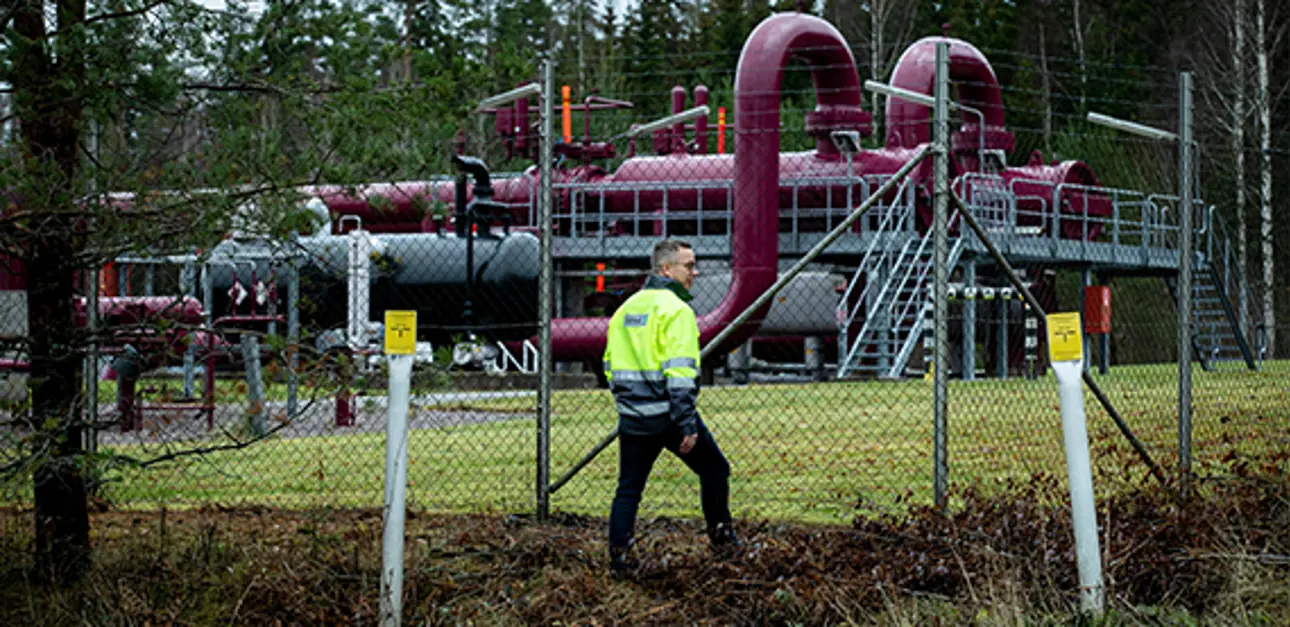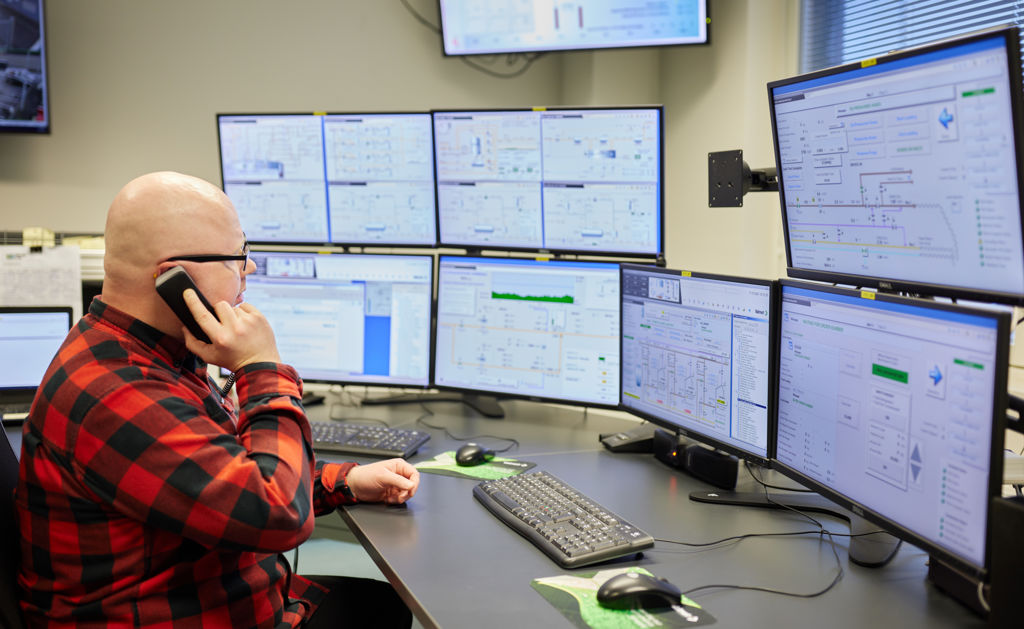Valmet automates the heating-up gas business
Liquefied natural gas, biogas and green hydrogen spread hope in the midst of climate change anxiety. Valmet wants its share of the growing market.

Thick red metal pipes curve above a grass field on the edge of a forest. Various colored tanks add to the steampunk atmosphere. We are standing next to the valves of a natural gas compressor station at the state-owned company Gasgrid in Mäntsälä, Finland.
“Often, so-called ‘pigs’ are sometimes pushed into the larger pipes,” says business manager Jani Hautaluoma, who is in charge of Valmet’s process automation in the gas sector.
A pig travels through the pipe along with natural gas and scrapes the pipe’s walls clean. At specific intervals, the intelligent piglet is inserted into the pipeline to research and report on the condition of the pipe.
This pig is not your normal sus scrofa domestica traditionally enjoyed at the Christmas table, but rather a mechanical cleaning capsule that makes cleaning and researching trips within a many tens of kilometers long natural gas pipeline and then gets lifted back out again to the ground.
Mäntsälä is one of the intersection points of Finland’s natural gas network. It is at this point, that both the old natural gas pipe from Russia meets the new Estonian Balticconnector gas pipeline, which started operations last year, running from Paldiski, Estonia, to Inkoo, Finland. These pipelines connect in Mäntsälä, and simultaneously, the compressor station increases the pressure of the gas so that it travels more effectively throughout Finland.
The main pipeline’s final station is in Hämeenkyrö from where a small plastic pipeline continues on to Ikaalinen. From the main pipeline, gas is shared using pressure reduction stations to dozens of retailers, for instance, to Auris Kaasunjakelu Oy located in Helsinki.
The compression station in Mäntsälä has been optimized and nearly fully automated. The station is controlled remotely from Kouvola.
Automation of the compression station is possible thanks to the advanced distributed control system (DCS). One of such systems can be also found from Valmet’s product portfolio and is the main product of the automation business line. The system controls the stations’ processes and equipment, for example, the valves and turbines. At the same time, operations are monitored by measuring equipment, the big picture is created from all perspectives, and various automatic reports are generated.
Thanks to Valmet’s system, many process stations can be fully automated, requiring either very few or even no personnel at all.
Burning coal is being phased out, and gas will be the replacement. Valmet is expanding its automation systems into new areas, ranging from gas terminals to logistics. Equipment operating with liquefied natural gas (LNG) is one of the newest areas for Valmet to master.
A good example is Tallink’s M/S Megastar, built in 2017 in Turku, Finland, which uses Valmet’s automation system.

Megastar, picture from Tallink
“The vessel’s engine operations, equipment and all other processes are automated with Valmet’s technology. Controlling fuel consumption is only a small part of its functionality,” Hautaluoma says.
Valmet is also interested in other liquefied natural gas operations in the marine industry, for example, bunker vessels. They transport fuel from terminals, trucks and bunker vessels to the vessels that operate with LNG, such as large cruise ships.
“These make up our potential market.”
Liquid gas bottles are familiar to people who grill at their summer cabins. Liquid gas is a mix of liquid propane and butane, which stays in a liquid form at room temperature up to a pressure of 8 bar. Car tires have a pressure of about 3 bar.
LNG is different. It requires a temperature of -160 °C to stay in a liquid form. If LNG gets warmer, then no amount of pressure can hold it.
“An LNG tank is always cold. That sets it apart from liquid gas. If it gets warm, the gas comes out of the tank for sure,” Hautaluoma says.
Trucks transporting the LNG don’t have their own coolers for the LNG. That’s why trucks transporting the gas always have to fight against time. The deadline is usually one week, two weeks at tops. After that, any warmed methane boils and disappears into the sky through a safety vault.
Natural gas is liquefied with compression. The principle is the same as in a refrigerator. Usually, the energy source is electricity.

Manga Terminal, control room, operator Tuomas Nissinen
LNG is collected at large terminals located, for example, in Tornio, Pori and Hamina. The gas is then transported from these terminals either through a pipeline to industrial clients or by truck or vessels to various locations.
One of Valmet’s customers in this business area is Tornio’s Manga LNG terminal, which is owned by Gasum and several other companies.
“Valmet has a local office with automation, reporting and other operational support in Tornio. Trucking companies are also connected to the service. The terminal does not do the logistics planning by itself any longer, rather logistics companies provide everything using our service,” Hautaluoma explains.
Somewhat counterintuitively, boiling the LNG at the terminal also keeps it simultaneously cold. Evaporation binds the energy. The same phenomenon can be observed with the frosting that occurs when a soda can is opened.
Valmet wants to join to green hydrogen revolution
Hydrogen has been a hot topic lately with heated investments. Still today, almost all the energy hydrogen is produced by steam reforming with either coal or natural gas. This produces approximately 800 million tons of greenhouse gas every year.
Valmet is very interested in green hydrogen. It is produced from water with electrolysis, which uses renewable energy to get the energy needed. The process is called P2G – or power-to-gas. This, too, is a new area for Valmet.
“Wind power and solar power will grow dramatically in the future, but production is highly cyclical,” Valmet business manager Jani Hautaluoma says.
“Production is scaled quite a bit, and there are times when there are huge amounts of excess electricity available. Then hydrogen and other compounds are produced. That’s when the need to produce green hydrogen arises,” Hautaluoma explains.
Valmet’s goal is to bring its automation solutions also to green hydrogen factories.
Green hydrogen is linked to synthetic methane, which is produced by combining hydrogen and carbon dioxide.
“Synthetic methane is exactly the same as biomethane or natural gas. So, Valmet’s current applications work in those processes. Hydrogen stations are very similar to gas stations,” Hautaluoma says.
In his vision, green hydrogen made from methane will travel through the same distribution network as the natural gas. Hydrogen can also be used in one’s own pipeline network and can be transported with the same trucks and in the same way as the other gases.
What is unusual in this process is that methane made from hydrogen turns back again into fossil fuel as interpreted by transportation regulations.
For more information:
Jani Hautaluoma, jani.hautaluoma (at) valmet.com
Original text in Kauppalehti in Finnish language. Written by JR Leskinen, jr.leskinen (at) almamedia.fi
The main picture made by Joel Maisalmi.